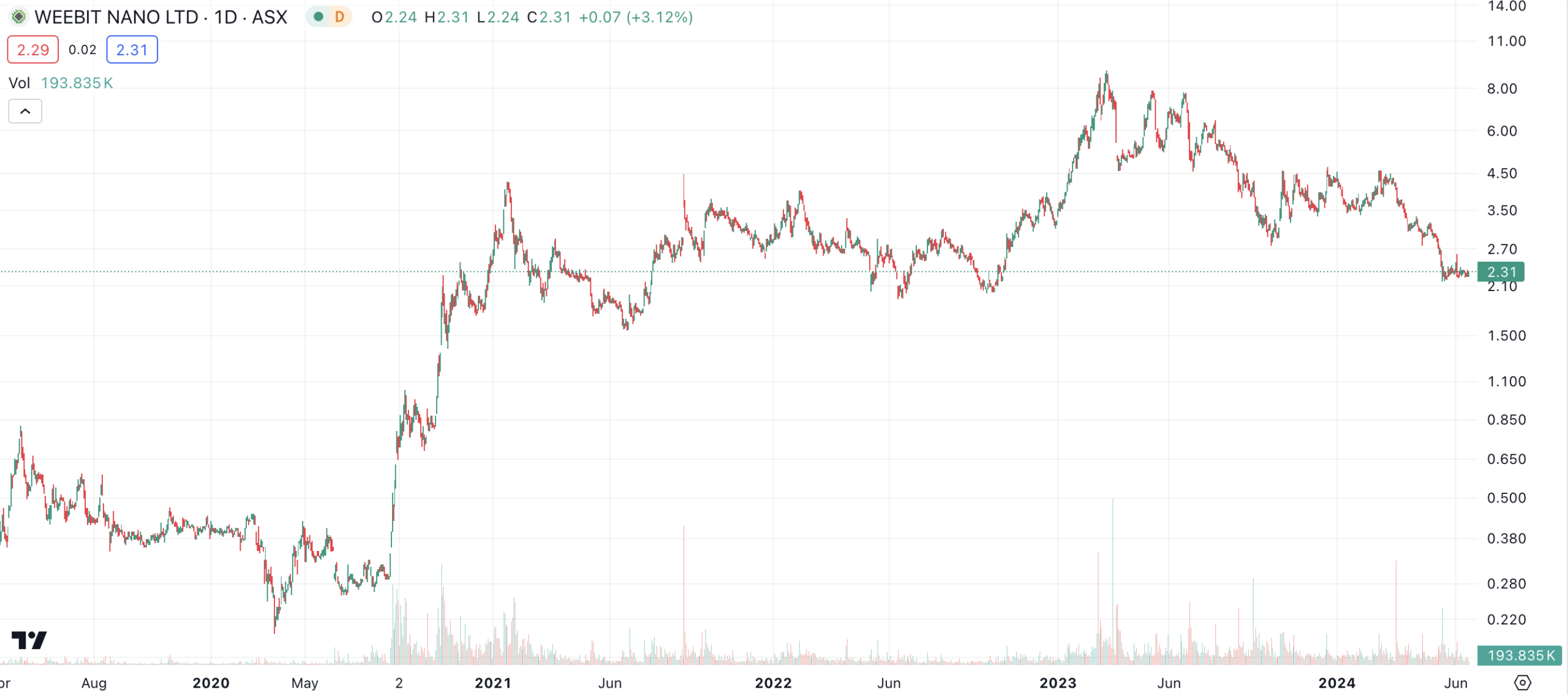Weebit Nano (ASX:WBT): Here’s why it has done so well and why the next 2 years will be extremely exciting!
![]() Nick Sundich, June 12, 2024
Nick Sundich, June 12, 2024
Our long-time followers would know we are big fans of Weebit Nano (ASX: WBT). This company has delivered stellar returns to shareholders over the past few years. But just where is this company at right now and what is next?
Disclosure: Stocks Down Under directors own shares in WBT.
This article was first published in July 2023, last updated in June 2024.
Who is Weebit Nano? And what is so special about its ReRAM?
Weebit Nano is a semiconductor technology development company that is listed on the ASX. The company specialises in a Non-Volatile Memory technology called Resistive Random Access Memory (ReRAM) that has strong potential to replace Flash memory technology, among other things.
Just about every electronic device needs Non-Volatile Memory to operate and this is typically some form of embedded memory. Have you ever noticed that electronic devices have become smaller while still being able to do more? Well, in part this is because computer chips, including memory chips and modules, are getting smaller and smaller, while their capabilities are increasing.
But the NVM market is at a critical juncture because stand-alone Flash memory cannot scale down below 40nm (nanometer), while embedded Flash can’t scale below 28nm, let alone while meeting increased growing performance needs. While not physically impossible, it would be commercially unviable to design this technology in a way that would cause it to be immune from problems, such as leakages of current between adjacent memory cells.
ReRAM has some major advantages over existing technologies
ReRAM technology is able to step in and fill the void. Although it is not the only alternative non-volatile memory technology, it is the most promising and WBT’s ReRAM specifically has several advantages.
In particular, it can perform 10-100x better than Flash because it can handle 100k-1m read/write cycles, can store and retain data for 10 years at 175C or 20 years at 125C, has a 100x faster access time, and can withstand up to 350x more radiation than Flash.
All the while, it adds far less to the cost of a semiconductor wafer than flash or other technologies and has lower power consumption levels and lower voltage requirements, thus enabling a longer battery life. And most critically, it can scale down further than Flash Memory, i.e. Weebit’s ReRAM has been taped-out at 22nm already and can likely be scaled down further below 20nm.
What are the Best ASX Stocks to invest in right now?
Check our buy/sell tips
WBT’s ReRAM is about to be commercialised
Since its ASX listing, Weebit has been developing its ReRAM technology with the intent of bringing it to market.
In mid-2021, the company signed a deal with US-listed semiconductor foundry SkyWater (NDQ:SKYT) to license its technology for embedded applications, integrate it into customer designs and commercialise it. A foundry is a chip maker that manufactures chips for third-party customers.
Ever since, SkyWater has been qualifying the technology – in other words, proving it can work in the context of SkyWater’s chips. WBT’s ReRAM is now available in SkyWater’s 130nm CMOS (S130) technology process, enabling SkyWater’s customers to integrate it in their system-on-a-chip designs and the first revenue was booked in November 2023.
In October 2023 Weebit signed its second commercial partner, in South Korean fab DB HiTek. As with SkyWater, the company’s technology will need to undergo a qualification process and this will take some months, although this was no doubt a sign of confidence in the company.
And in June 2024, Weebit announced another major deal, in the form of a collaboration with California-based chip design services company Efabless. eFabless helps its customers put their product ideas into chip designs using proprietary design and workflow tools. This deal provides for Weebit to get a fee if ReRAM is included in a design, and chip designers will need to take out a full license agreement if the chip goes into volume production. Although this collaboration is not likely to bring in more than modest revenues initially, this prototyping may provide Weebit with momentum when it comes to the integration of ReRAM into new chip designs as well as inroads into companies it may not be talking to yet. We reckon Weebit could land further commercial deals in 2024.
With all current deals, the company is pursuing a licensing model and intends to do likewise with future partner fabs. WBT will generate revenue in the form of license fees (upfront and milestone payments), a per-unit royalty and Non Recurring Engineering (NRE) fees. The royalty percentage could be 1.5-3%, based on industry standards.
To illustrate how this might work, let’s assume a foundry can make a chip using WBT’s technology that costs US$10 per unit and WBT receives a 3% royalty on all sales of chips that use its technology. If the foundry sells 1m of these chips and generates US$10m in sales, WBT would receive US$300,000 from this customer for this product.
Looking forward to more commercial deals
There is a lot to look forward to for investors in Weebit. ReRAM will be made available in smaller geometries – the company has been working on applications at 28nm and 22nm for a while, and we expect it will likely scale this technology down below 20nm in the near-future.
And although SkyWater and DB HiTek are the only fabs that WBT have formal commercial arrangements with, the company is engaging with the majority of the world’s tier-1 foundries and is doing evaluations with some of them. Furthermore, WBT is working informally with GlobalFoundries, another major American semiconductor manufacturer that is a significant worldwide player, particularly in the Automotive chip market.
Qualified for Automotive and Industrial applications
We think GlobalFoundries could be the next commercial partner – and potentially the best given it could be WBT’s gateway to the Automotive market. GlobalFoundries has a deal with General Motors (GM) to exclusively manufacture chips in the USA to be used in GM’s vehicles. The recent qualification of WBT’s ReRAM in up to 125 degrees Celsius (the temperature for automotive grade NVMs) illustrates that it is up to the job. Consider that most chips for general consumer applications only need to pass tests of up to 85 degrees celcius!
We take heart from moves by Taiwan Semiconductor Manufacturing Corp (TSMC) in the ReRAM space. TSMC has its own ReRAM technology that is integrated into certain chips it manufactures. Although the company has not confirmed this, ReRAM is probably being used in the iPhone 14 given TSMC makes chips for this phone.
Unless TSMC decides to let competing fabs use its technology, WBT will be one of the few viable alternative ReRAM technologies on the market and the only practical one at that. We believe WBT is also likely to attract interest from Integrated Device Manufacturers (IDMs), such as Intel, STMicro, Texas Instruments, NXP etc, as well as fabless chip companies, like Qualcomm, Broadcom and NVIDIA.
The opportunity is very substantial
The Non-Volatile Memory market was worth US$74.6bn in 2022 but is expected to grow at 10.7% CAGR to reach US$124.1bn by 2027.
Weebit is targeting 3 individual segments in this market:
- Embedded Memory
- Discrete Memory
- Neuromorphic computing
The embedded market will be the first market to be targeted. The embedded emerging NVM market is expected to amount to $2.9bn by 2027 and it is expected that ReRAM will capture a 33% market share, representing $957m. Embedded NVM is memory contained in a SoC (System on a Chip), which is a chip design that contains all the elements of a computer system in that one chip rather than in several different components on a board as is the case with discrete NVM chips.
Potential applications include Mixed Signal, Analog and Power Integrated Circuits (IC’s), IoT devices, Edge AI, Automotive/Industrial, Aerospace, and Defence. All of these markets represent compelling opportunities although we believe WBT’s ReRAM is most likely to first enter the IOT and Automotive segments before any others.
In the medium term, we see potential for ReRAM to enter the discrete NVM segment. This is the segment that is home to every day devices and the underlying technologies such as mobile phones, PCs, tablets, USB drives and data centres. The market opportunity is US$3.3bn by 2026 and approximately 13% of this is expected to be captured by ReRAM. Although WBT is focusing on the embedded NVM segment in the near-term, it has made some progress in pursuing the discrete NVM segment by developing a BEOL (back end of the manufacturing line) selector and demonstrated its integration with ReRAM cells.
We’re very bullish on WBT’s share price
The company’s share price has gained over 1,500% since mid-2020. But is there more growth to come?

Weebit Nano (ASX:WBT) share price chart, log scale (Source: TradingView)
We think there is. We have most recently valued the company at $9.56 per share – a ~66% premium to the current share price. This was based upon valuing it at 25% of the value of Taiwanese listed peer eMemory (TW:3529), while WBT currently trades at just ~17% of that company’s valuation.
Although eMemory is further advanced, we think it is a great example of what WBT’s journey may look like, specifically because, like eMemory, WBT aims to complement its future customers’ IP libraries with proprietary IP in a highly lucrative licencing model.
There are several catalysts for WBT’s share price, including:
- The first commercial customers for WBT/SkyWater’s S130 process,
- Additional commercial agreements and/or collaborations with other foundries and IDM’s,
- Positive progress reports on WBT’s continued R&D for lower densities,
- Potential M&A discussions involving the acquisition of the compant or part of its IP.
Keep your eye on WBT!
We think WBT has earned its re-rating over the last several years. But we think the best is still to come from this company – we expect further growth to come as it achieves the catalysts above.
For more information on this great company, check out our library of reports from our sister company Pitt Street Research!
Disclosure: Weebit Nano is a Pitt Street Research client and directors own shares in this company.
Blog Categories
Get Our Top 5 ASX Stocks for FY25
Recent Posts
Kamala Harris stocks: If Joe Biden’s VP wins the White House in 2024, which stocks will win?
With the US Presidential election now certain to be a Kamala Harris v Donald Trump showdown, we’ve looked at so-called…
South32 (ASX:S32): Is it the dark horse amongst ASX 200 miners or have cyclones and commodity prices hit it too hard?
South32 (ASX:S32) began life as a spinoff from BHP back in 2015, capitalised at $9bn. In mid-2024, it is capped…
Here’s why drug reimbursement is so important for ASX healthcare stocks
Let’s take a look at the concept of drug reimbursement, something that is crucial for ASX healthcare stocks looking to…



